

ABOUT « SocioPatterns.org. SocioPatterns is a collaboration between researchers and developers from the following institutions and companies: ISI Foundation – Turin, ItalyCNRS – Centre de Physique Théorique – Marseille, FranceBitmanufactory – Cambridge, UK It was originally created by A.

Barrat (CNRS & ISI Foundation), C. Cattuto (ISI Foundation), J.F. Pinton (ENS Lyon) and W. Ciro Cattuto (ISI Foundation)Alain Barrat (CPT, CNRS & ISI Foundation) You can contact us at info [at] sociopatterns.org. Christopher Alexander. "The Structure of Pattern Languages", by Nikos A. Salingaros. Federating efforts towards a thrivable world. Microsoft Word - COINs13_iba_final.docx - 1308.1178.pdf. Christopher Alexander - a theory of incremental design. You probably know Christopher Alexander, at least indirectly.
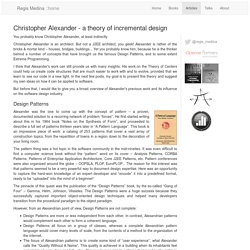
Christopher Alexander is an architect. But not a J2EE architect, you geek! Alexander is rather of the bricks & mortar kind – houses, bridges, buildings... Yet you probably know him, because he is the thinker behind a number of concepts that have brought us the famous Design Patterns, and to some extent Extreme Programming. I think that Alexander's work can still provide us with many insights. Scientific Introduction to the Nature of Order by Christopher Alexander. The Art of Observation: Understanding Pattern Languages. Review: The Art of Observation: Understanding Pattern Languages Werner Ulrich University of Fribourg, SWITZERLAND; The Open University, UNITED KINGDOMwulrich@gmx.ch The Timeless Way of Building.
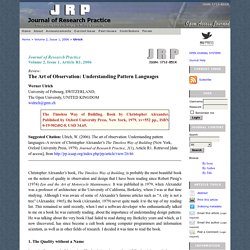
AlexanderPresentation.pdf. Models vs. Patterns. Pattern language. A pattern language is a method of describing good design practices within a field of expertise.
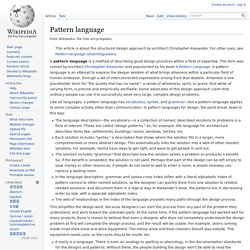
The term was coined by architect Christopher Alexander and popularized by his book A Pattern Language. A pattern language is an attempt to express the deeper wisdom of what brings aliveness within a particular field of human endeavor, through a set of interconnected expressions arising from that wisdom. Aliveness is one placeholder term for "the quality that has no name": a sense of wholeness, spirit, or grace, that while of varying form, is precise and empirically verifiable. Some advocates of this design approach claim that ordinary people can use it to successfully solve very large, complex design problems.
Helmut Leitner: Pattern Languages and Christopher Alexander: Introduction and Crash Course. Other Events Listings. Grasping the Ineffable: From Patterns to Sequences. Grasping the Ineffable: From Patterns to Sequences Jenny Quillien Quillien teaches in the Laboratory of Anthropology, New Mexico University at Highlands, Santa Fe, New Mexico.
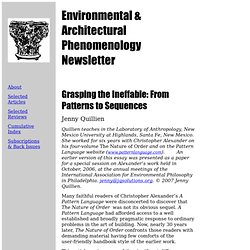
She worked for six years with Christopher Alexander on his four-volume The Nature of Order and on the Pattern Language website (www.patternlanguage.com). An earlier version of this essay was presented as a paper for a special session on Alexander’s work held in October, 2006, at the annual meetings of the International Association for Environmental Philosophy in Philadelphia. Jenny@jqsolutions.org. © 2007 Jenny Quillien. COMMENT SAISIR L’INSAISSIABLE - 0701quillien.pdf. Systems generating systems — architectural design theory by Christopher Alexander (1968) The systems thinking roots from architect Christopher Alexander aren’t completely obvious in his work on pattern language.
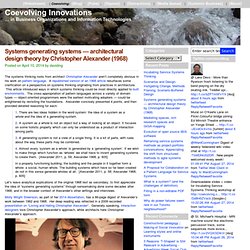
A republished version of an 1968 article resurfaces some clarification on a perspective on systems thinking originating from practices in architecture. This article introduced ways in which systems thinking could be most directly applied to built environments. The cross-appropriation of pattern languages across a variety of domain types — object-oriented programmers were the earliest motivating adopters — could be enlightened by revisiting the foundations.
Alexander concisely presented 4 points, and then provided detailed reasoning for each: 1. Let’s leave analytical explications of the original 1968 text as secondary, to first appreciate the idea of “systems generating systems” through sensemaking done some decades after 1968, and in the broader context of Alexander’s other writings and interviews. [....] 275Ibid., xi.276Alexander, The Timeless Way of Building, 186. Chefs, Not Recipes: The Tyranny of Tools and Best Practices. One of my favorite sayings is, “Chefs, not recipes.”

It’s a phrase that I stole from Dave Snowden, and it perfectly encapsulates the approach I think we need to take (and aren’t) in the collaboration, networks, and organizational development space. I believe in this so strongly that I had it engraved on the back of my phone. What exactly does this mean, and why do I find it so important? One of the reasons I got into this field was that, over a dozen years ago, I experienced exceptional collaboration in open source software development communities, and I wondered whether similar things were happing in other places. A Lecture on the Christopher Alexander’s books The Nature of Order. b… A Pattern Language : Christopher Alexander, Sara Ishikawa, Murray Silverstein. WHAT IS THE NATURE OF ORDER ALL ABOUT - empirical-findings.pdf. Helmut Leitner: Pattern Languages and Christopher Alexander.
Alexander Pattern Language Summary. Pattern Languages As Media For The Creative Society - Takashi Iba. Open Source Ecology: Pattern Language. A pattern language is defined in Wikipedia: This concept is extended here to a pattern language of open source hardware.
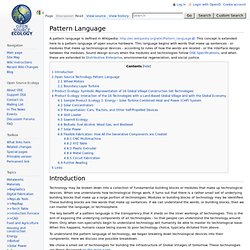
This language begins with words that make up sentences - or modules that meke up technological devices - according to rules of how the words are related - or the interface design between the modules. Sound design occurs when the modules and technologies follow OSE Specifications, and when these are extended to Distributive Enterprise, environmental regeneration, and social justice. Technology may be broken down into a collection of fundamental building blocks or modules that make up technological devices.
When one understands how technological things work, it turns out that there is a rather small set of underlying building blocks that make up a large portion of technologies. Modules or building blocks of technology may be identified. The key benefit of a pattern language is the transparency that it sheds on the inner workings of technologies. Wheel Motors. Peeragogy Patterns. Although a grounding in learning theory helps inform peer learning projects, Peeragogy, at its core, comes to life in applied practice.

Even before convening a group for your peer learning project, you will want to take a look over the patterns we have collected here. You will likely return here many times as your project develops. What is a pattern? A pattern is anything that has a repeated effect. In the context of peeragogy, the practice is to repeat processes and interactions that advance the learning mission. PatternPedia - Wiki-based Pattern Repository. Watch in HD for best performance.
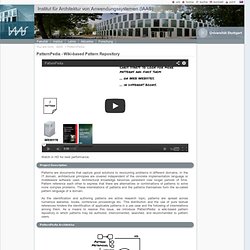
Patterns are documents that capture good solutions to reoccurring problems in different domains. In the IT domain, architectural principles are covered independent of the concrete implementation language or middleware software used. Architectural knowledge becomes persistent over longer periods of time. Cloud Computing Patterns. Group Works Card Deck – A Joyful Announcement. For the past couple of years a group of professional facilitators and others experienced in and interested in improving “group process” has been working to create a “pattern language” (an integrated collection of practices, processes, qualities and other phenomena that “work” in many different group contexts and at different scales) to improve the effectiveness of meetings, conferences and other deliberative gatherings. I have had the privilege to have been part of the core team developing this “language”.
When we started, we expected to produce a book, but instead we decided to produce a card deck, to make the tool more interactive, dynamic and fun. Permaculture Flower Pattern Language by Adam Brock on Prezi. Co-Creative event pattern language. V1.0 Beta Summary As a group of people, it’s easier to join and work together AGAINST something than FOR something.Command and control or consensus work model have limitations for group organization (Marsh, H. 2012).It has to do partly with the difficulty of on agreeing on a common goal and sharing a common intent, particularly in large groups. Visible and invisible architectures Visible and invisible architectures structure the spaces in which we evolve individually and collectively and therefore The same architecture is likely to trigger the same collective outcomes no matter what topics, challenges, market places and players are in its center.
Co-creative events patterns.
Liberating Structures - Introduction. PatternDynamics™ Fearless Change. Dreamsongs. Scrum Organizational Patterns. Welcome! Though this page is called "Published Patterns," all of the active patterns are listed including Works in Progress. However, you can't see the Works in Progress unless you are an author, because we want to encourage authors to openly offer their works only to a community of trusted critics. Also, we want you to check this page if you are considering writing a pattern, because someone else may already be on the task. For additional historical context, see also and The ScrumPLoP Product Backlog is on the Product Backlog Spreadsheet. 21 Card Decks for Creative Problem Solving, Effective Communication & Strategic Foresight.
What are some useful playdecks for sparking creativity and innovation? That was this week’s question that went out on twitter, and below are some of your responses. The number of decks out there is large, so I decided to curate this list based on whether there’s a full free version available online, or at the least a nice sample deck to get you started. So below are 21 tools, ranging from general design process principles to cards on game dynamics, facilitation methods, and long-range futures thinking. Under the descriptions, which are excerpted from the playdeck websites, are links to their free downloads. Design with Intent toolkit. Models Pages. Liberating Voices Pattern Language. Ingress. Brunopostle / Urb / wiki / Patterns. Part One: Pattern Languages (or architecture for programmers) This short series of articles is aimed squarely at members of the Free Software community.
What I hope to do is point out some interesting architectural ideas that are generally considered outside the mainstream, but which I think have some real resonance with Free Software practices. Then I want to show how we can to put these ideas and practices together and make something genuinely useful. Introduction. Sample Page. PLoP 2014 - 21st Conference on Pattern Languages of Programs, Monticello, Illinois. Incubating Service Systems Thinking.
Posted on August 26, 2014 by daviding Evolving the Proposal to Collaborate on a Pattern Language for Service Systems from January, the initiative has now taken on a label of Service Systems Thinking. The presentation at the 58th Annual Meeting of the International Society for the Systems Sciences in Washington DC was recorded, so that interested parties have the option of watching or listening ideas that have developed over the past six months, and reading the slides at their leisure. 2014/01/26 A Proposal for Collaboration on a Pattern Language for Service Systems (Science, Management, Engineering and Design) Author David Ing. Through the Dark Mountain: A Harvest of Myths. Shaka, When the Walls Fell - Ian Bogost. Will2013a.pdf. Details view: An Open Source Pattern Language (re)generative of Commons. An ecology for systemic change. How to foster and empower disruptiv...
Coalescing Efforts towards a Thrivable World: A Pattern Language for Systemic Change. Engagement Logics and the logics of the commons.